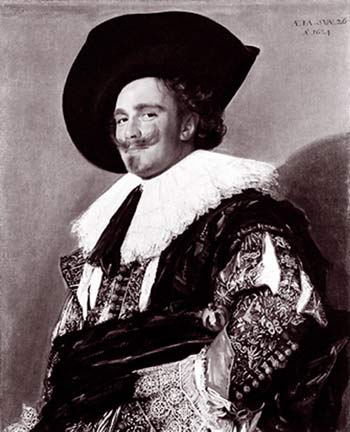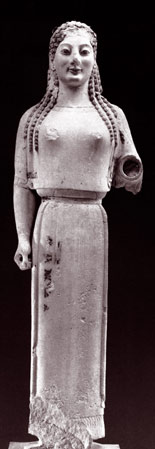“笑”是人類最基本的情感表達(dá)方式,但中外各個歷史時期對“笑”的刻畫卻大不相同:古希臘雕像笑得端莊高雅,佛蘭芒畫家筆下的少年笑得天真調(diào)皮;幾百年前,人們以笑不露齒為禮儀,而今人們則開懷大笑,盡情展露內(nèi)心的喜悅。

By Rob Hardy
齊化科 選注
Say “cheese.”
If you say cheese, you are ready for the photographer to render a picture-perfect portrait complete with smile. That’s the way it has been since around 1920, when photographers at British public schools[1] developed the tradition. And yet that is not the way it has always been.
In Australia there is a fashion for saying “money.” Spaniards say “patata” (potato) and the Japanese use the English word “whisky.” The Czechs used to use the Czech word for cheese, but now say “fax” which may hurtle them into modernity.[2] Plenty of languages don’t have a smile word; the photographers just ask for a smile and the subjects do the best they can.
We don’t smile just for the photographer, of course. Let’s examine smiles in art. You can bet the Mona Lisa is here, as is Frans Hals’s[3] Laughing Cavalier. There is a famous “archaic smile”[4] on early Greek sculpture. The figures of young men and women stand stiffly, but their mysterious smiles give them a reassuring amount of life.[5]

Dutch and Flemish painters of the 17th century had a favorite subject of the “hennetaster,” or “chicken groper,” a boy who smiles as he feels up a hen to see if she has an egg on the way.[6] These enormously popular paintings were riotously funny to their owners and the guests to whom they were displayed; the humor in part derived from the interchangeability of the Dutch words for bird, birds, or hens with those for genitalia, women, and other double entendres.[7]
Jesus smiles as he undergoes crucifixion, and some of the Romanesque sculptures,[8] which otherwise have very small mouths, are brightened by surprising smiles.
The nerves that make a natural smile are different from the ones activated when we force a smile, and so the two smiles look different; sometimes neurological patients[9] will be able to do one of the smiles but not the other. 30% of Americans show their canine teeth[10] when they smile, and only 67% turn up the corners of the mouth when they smile. No one really knows why tiny babies smile except that it is a trick calculated[11] to make the adults around them like them; of course it works.
Laughing has been thought to be bad taste; Lord Chesterfield advised his son, “The vulgar often laugh, but never smile; whereas well-bred people often smile, but seldom laugh.”[12] We are smiling more heartily now, and this is because of modern dentistry, which encourages display of healthy teeth, and modern photography, which can catch a spontaneous smile when previously sitters had to keep immobile for long periods of time to make a portrait.[13]
Vocabulary
1. public school: 在英國和威爾士指公學(xué),一種貴族化的私立付費(fèi)學(xué)校,實行寄宿制,常為大學(xué)的預(yù)科學(xué)校。在美國和蘇格蘭指初等或中等公立學(xué)校。
2. Czech: 捷克人(的),捷克語(的);hurtle: 猛投,猛扔;modernity: 現(xiàn)代狀態(tài)。此處語帶調(diào)侃:與歐洲發(fā)達(dá)國家相比,捷克的經(jīng)濟(jì)比較落后,句中作者調(diào)侃捷克人用fax(傳真)一詞,希望能讓自己顯得先進(jìn)些。
3. Frans Hals: 弗蘭斯?哈爾斯(1580?—1666),荷蘭肖像畫家和風(fēng)俗畫家,用色簡樸而明亮,善于表現(xiàn)人物的個性和神態(tài),句中提到的Laughing Cavalier(《微笑騎兵》)為其代表作。
4. archaic smile: 古風(fēng)式微笑,是古希臘古風(fēng)時期(the Archaic Period of Ancient Greece,約600BC—480BC)希臘雕像特有的微笑,特征為嘴角微微上揚(yáng)。其研究者有兩種看法:一種認(rèn)為古風(fēng)式微笑反映了人們健康的情緒和幸福的生活,另一種認(rèn)為是雕刻難度造成的。但后人都把這種微笑視作端莊、典雅的笑容。
5. stiffly: 僵直地;reassuring: 安慰性的,使人安心的。
6. 17世紀(jì)的荷蘭和佛蘭芒畫家喜歡將hennetaster,即“摸雞者”作為主題,畫的是一個男孩兒,一邊笑一邊摸著一只母雞,看看它是不是快下蛋了。Flemish: 佛蘭芒的,此處的Flemish painters指15至17世紀(jì)比利時和法國北部的佛蘭芒畫派的畫家。
7. riotously: 非常滑稽有趣地;interchangeability: 可互換性;genitalia: 生殖器;double entendres: <法>(常有猥褻含義的)雙關(guān)語。
8. undergo: 遭受,忍受;crucifixion: 釘死于十字架;Romanesque:(雕刻、繪畫等)羅馬式的,11至12世紀(jì)盛行于西歐。
9. neurological patient: 神經(jīng)系統(tǒng)疾病患者。
10. canine tooth: 犬齒。
11. calculate: 打算,計劃。
12. Lord Chesterfield: 切斯特菲爾德勛爵(1694—1773),英國著名政治家兼文人,他向兒子傳授禮儀與學(xué)識的信是西方倍受推崇的家書;the vulgar: 粗俗之人,平民;well-bred people: 知書達(dá)理之人。
13. dentistry: 牙科醫(yī)術(shù);spontaneous: 自發(fā)的,(舉止等)自然的;immobile: 一動不動的。
(來源:英語學(xué)習(xí)雜志)
